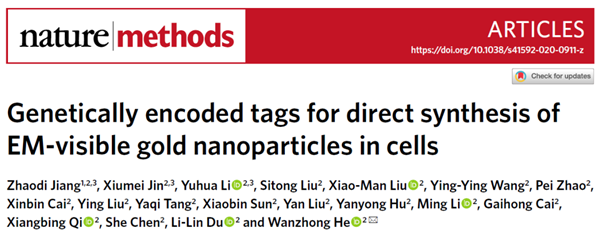Home> News
Chinese research team develops new approach for genetically encoded tags for single-molecule imaging in electron microscopy
Updated: 2020-08-13

A paper entitled Genetically encoded tags for direct synthesis of EM-visible gold nanoparticles in cells – produced by a research team from the National Institute of Biological Sciences in Beijing -- is published in the journal Nature Methods. [Photo/WeChat account of BSC]
A research team -- from the National Institute of Biological Sciences in Beijing – recently reported an approach for directly synthesizing electron microscopy (EM)-visible gold nanoparticles (AuNPs) on cysteine-rich tags, for single-molecule visualization in cells. The academic paper was published in the journal Nature Methods on Aug 10, according to the public WeChat account of the Biophysical Society of China (BSC).
Led by He Wanzhong, the research team first uncovered an auto-nucleation suppression mechanism that allows specific synthesis of AuNPs on isolated tags.
The team then exploited this mechanism to develop approaches for single-molecule detection of proteins in prokaryotic cells and said it achieved an unprecedented labeling efficiency.
The team moved on, expanding it to more complicated eukaryotic cells and successfully detecting the proteins targeted to various organelles. These included the membranes of an endoplasmic reticulum (ER) and nuclear envelope, ER lumen, nuclear pores, spindle pole bodies and mitochondrial matrices.
The team further implemented cysteine-rich tag–antibody fusion proteins as new immuno-EM probes.
